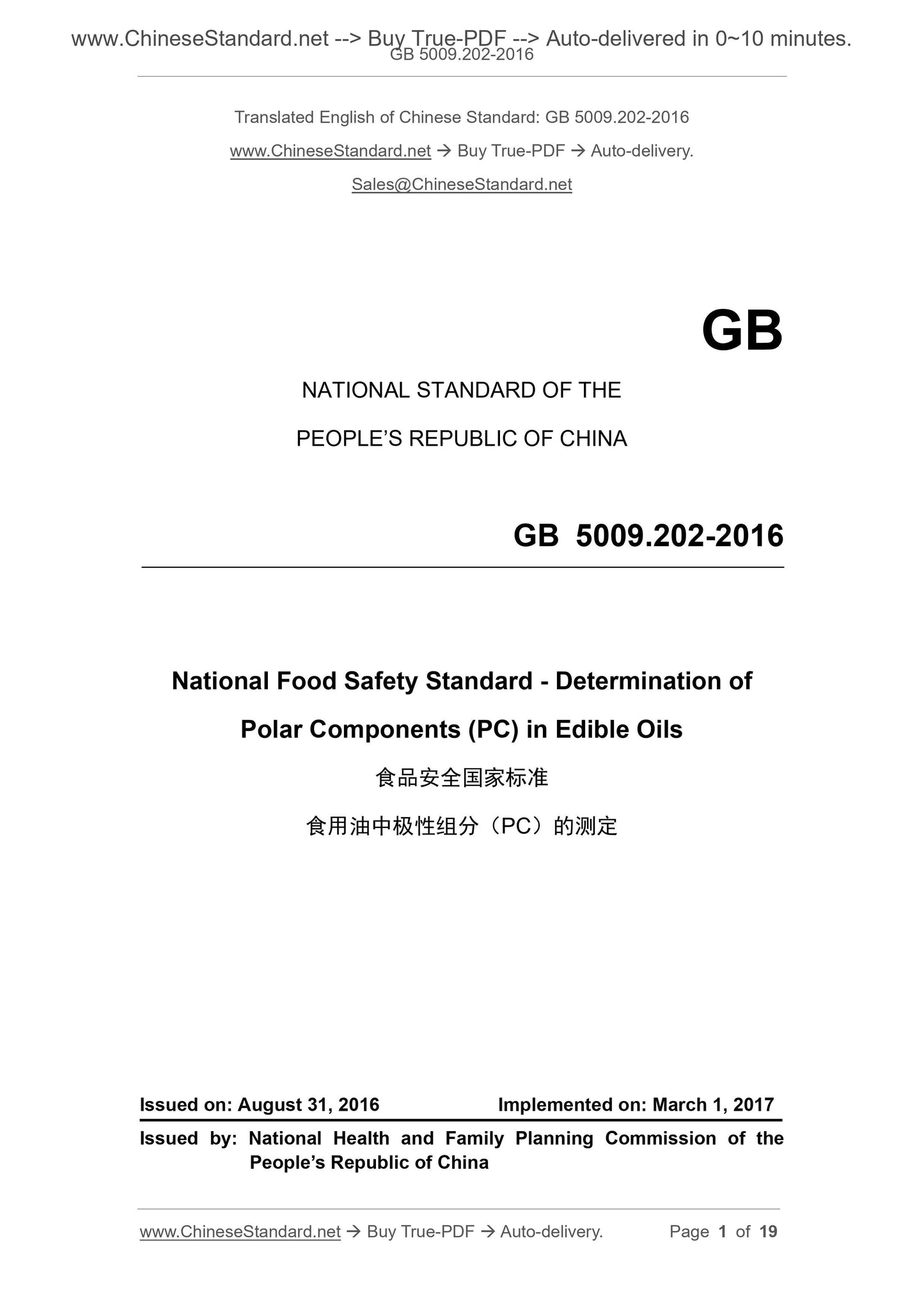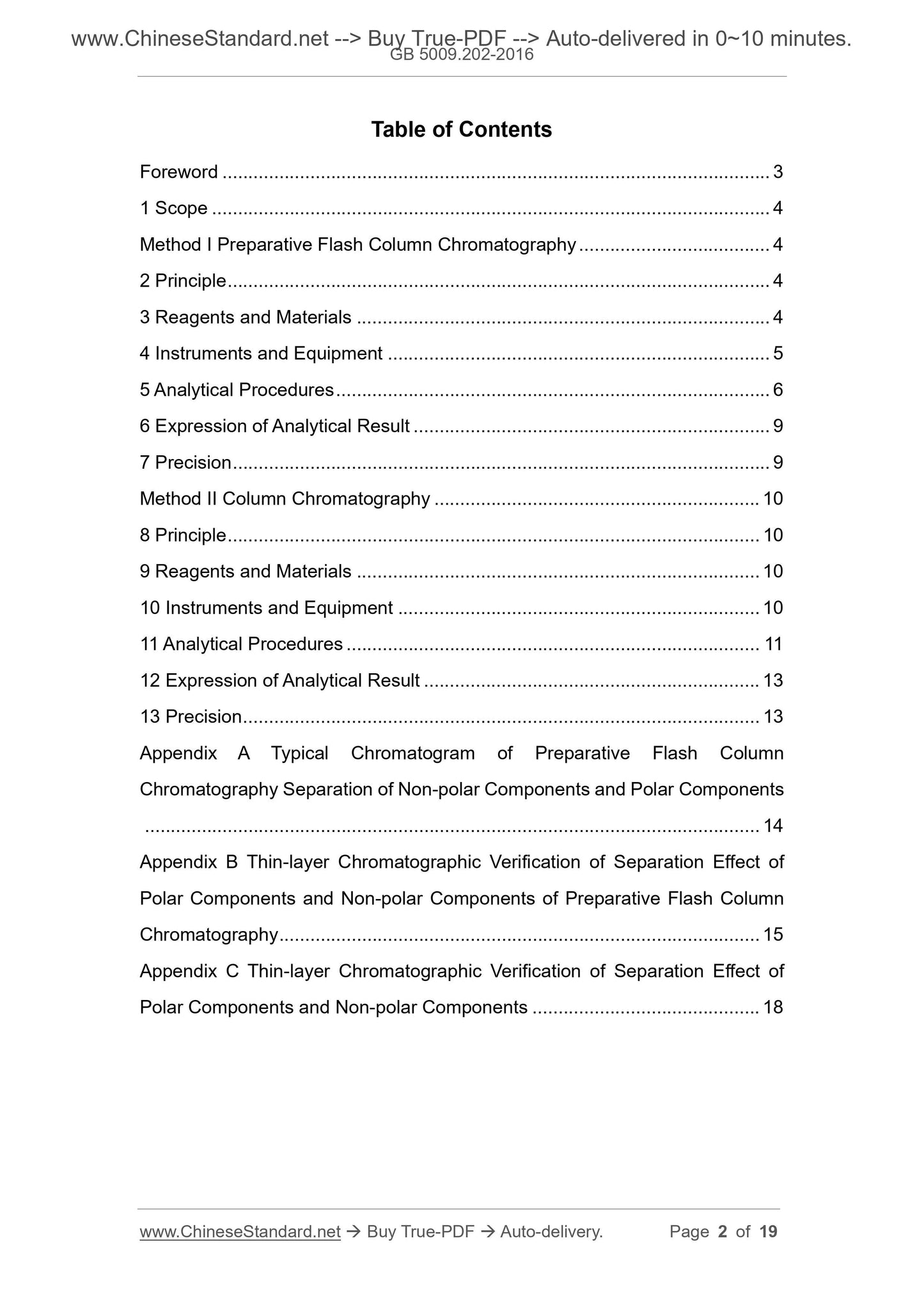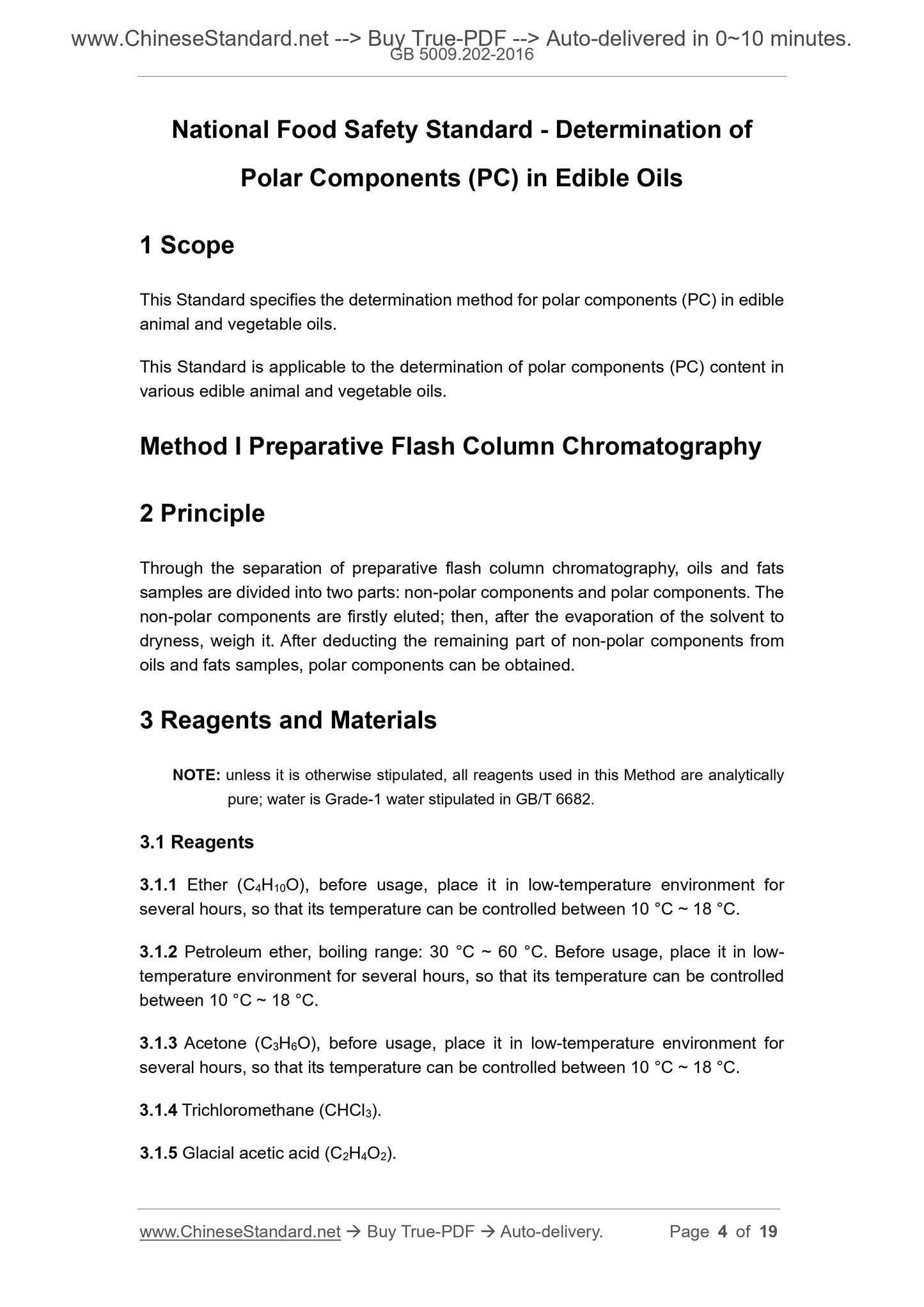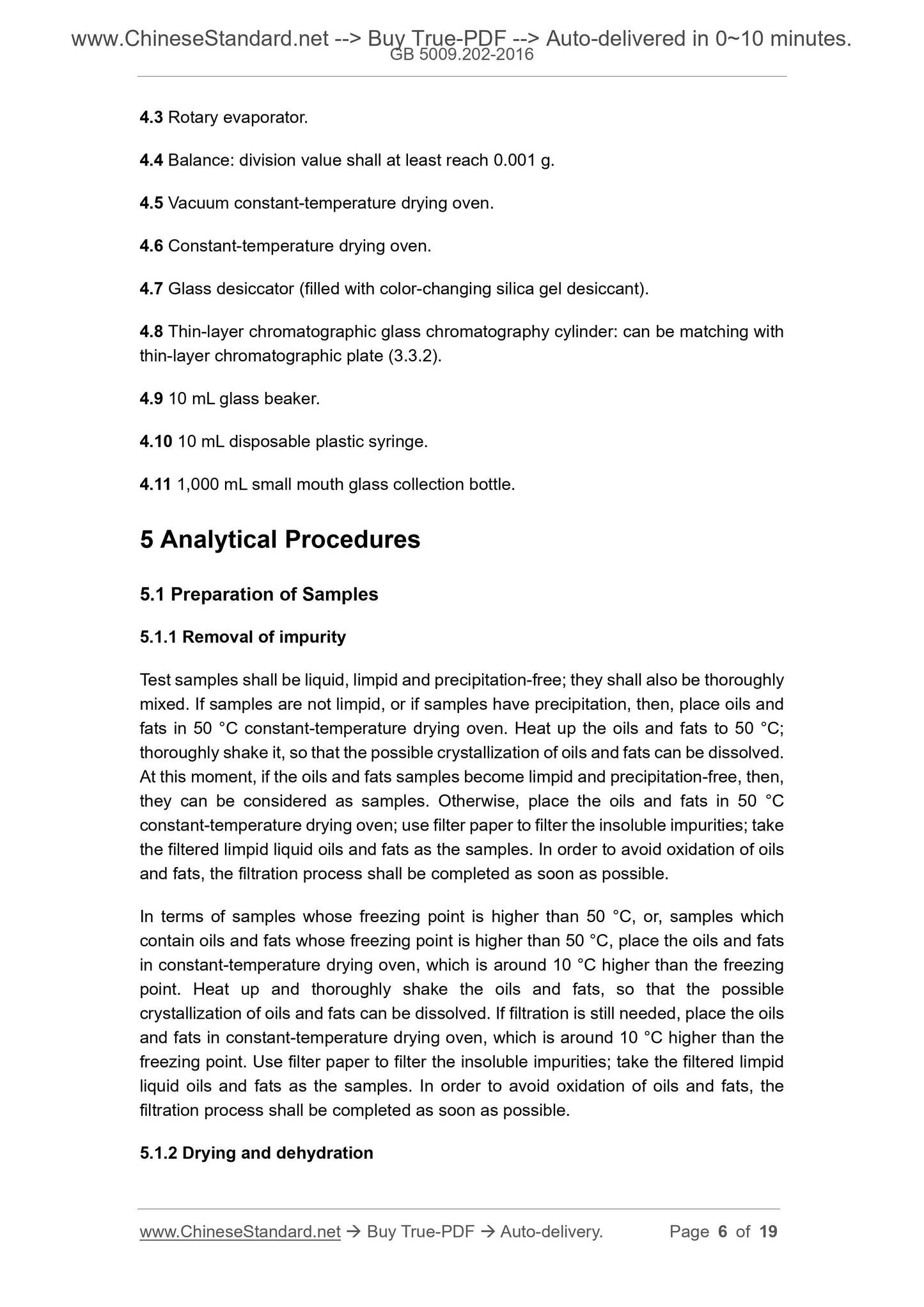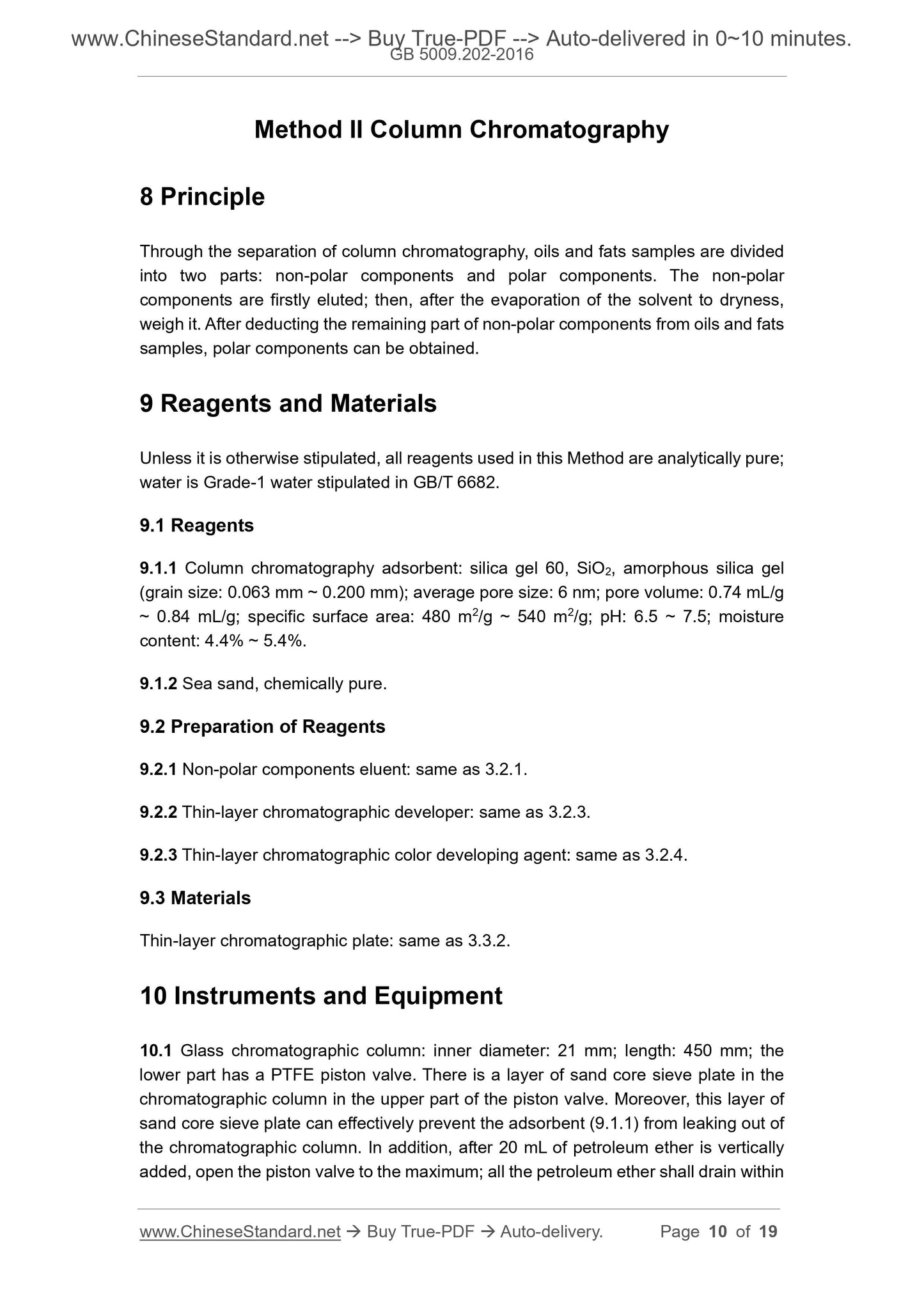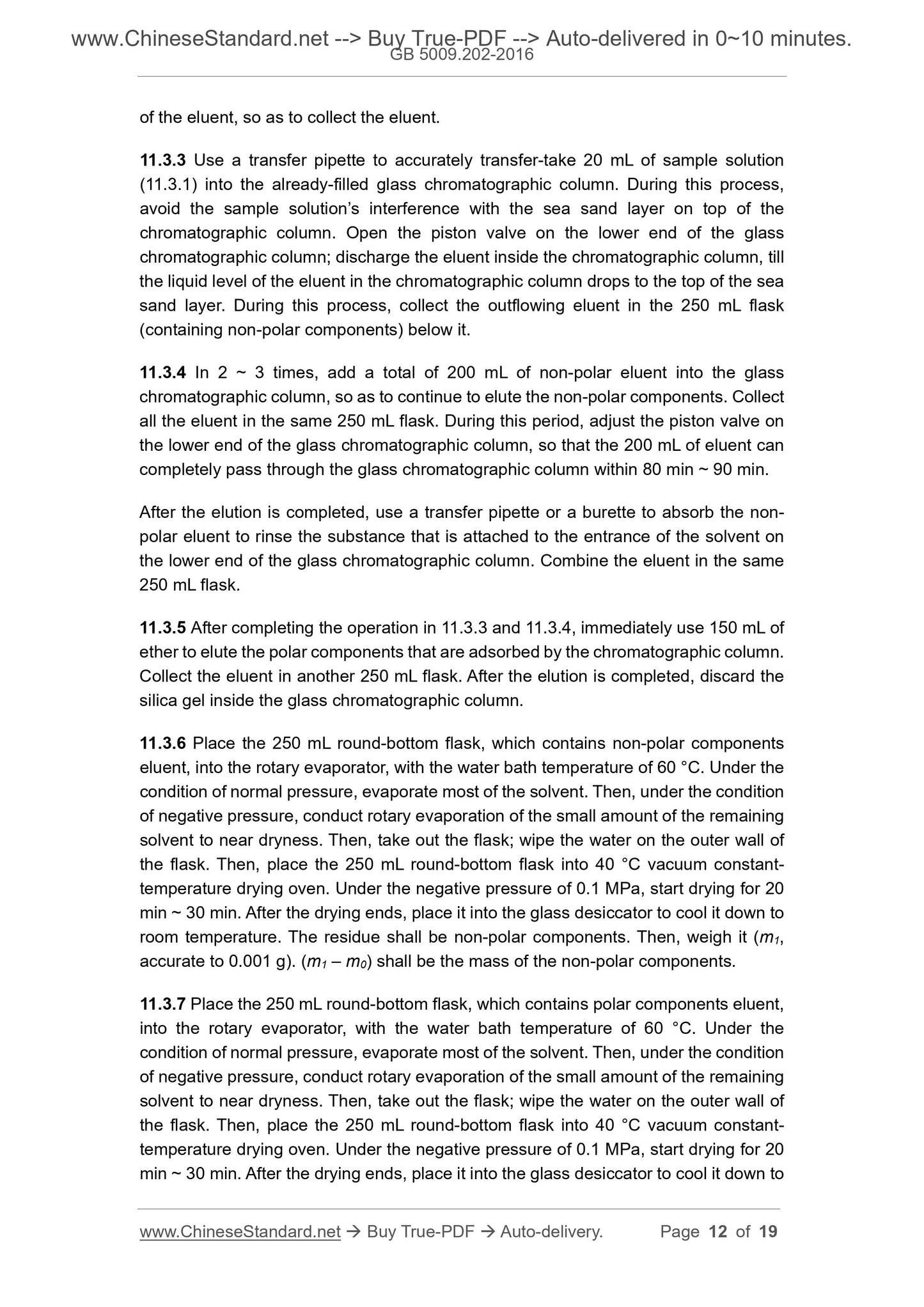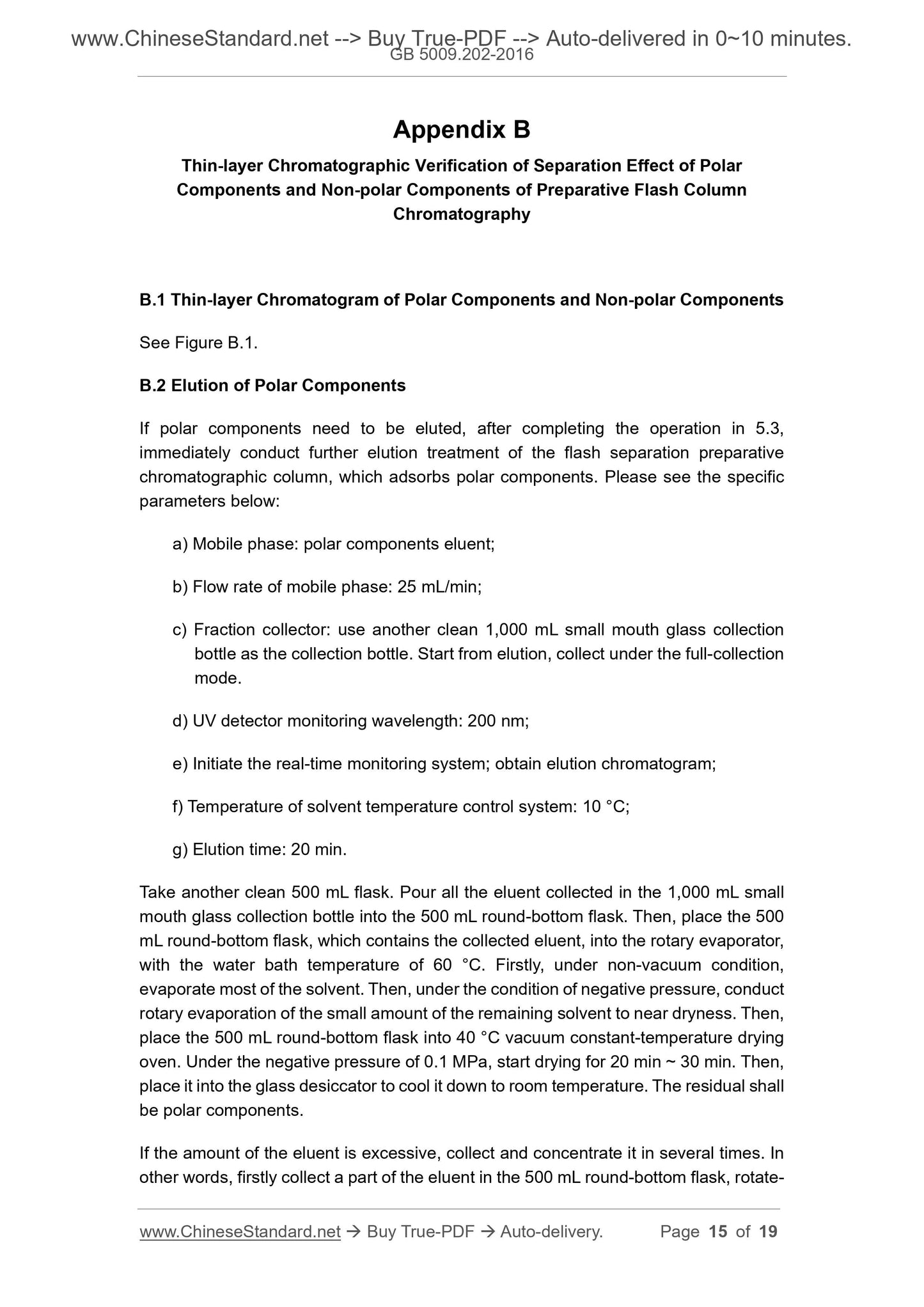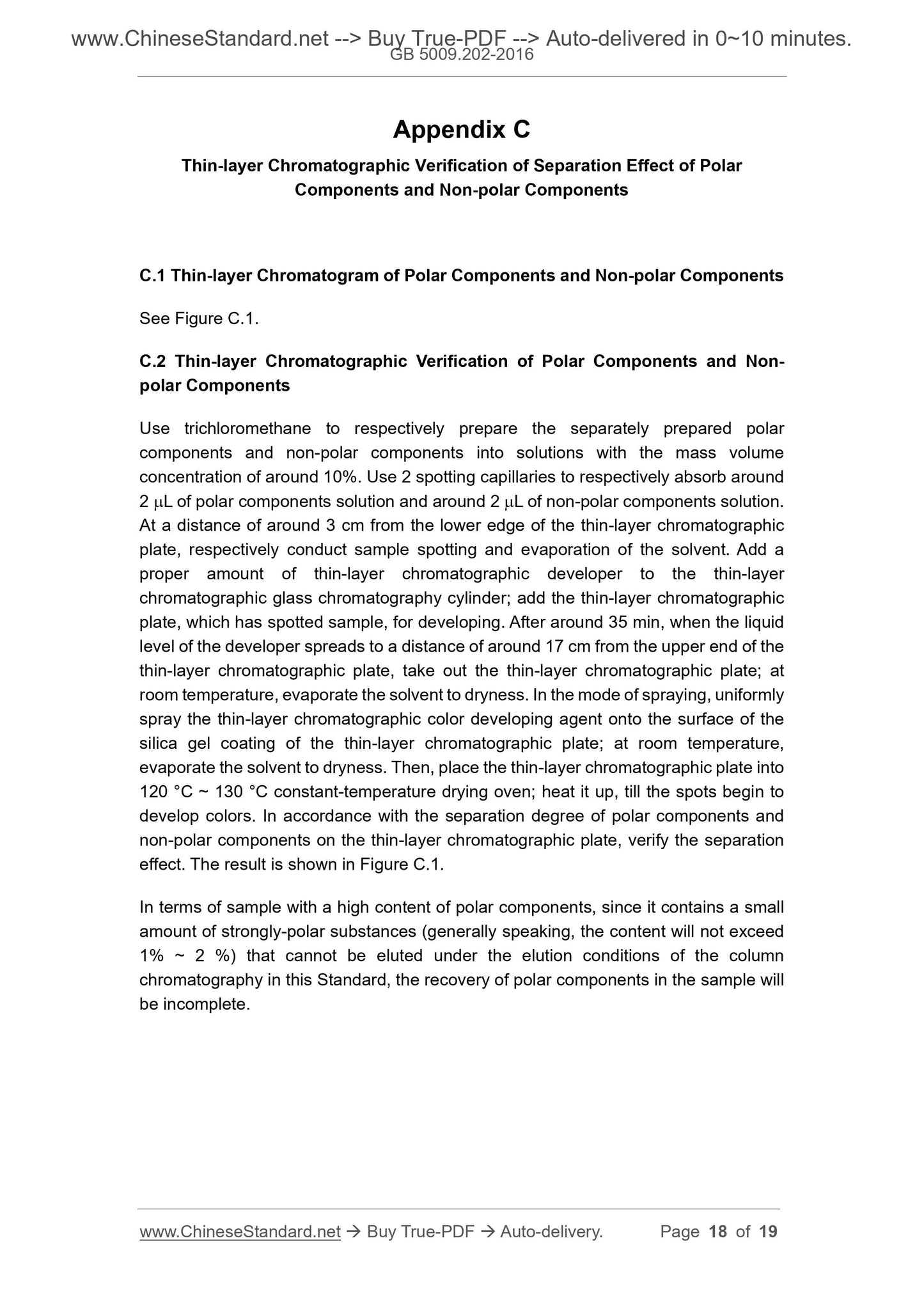1
/
of
8
www.ChineseStandard.us -- Field Test Asia Pte. Ltd.
GB 5009.202-2016 English PDF
GB 5009.202-2016 English PDF
Regular price
$130.00
Regular price
Sale price
$130.00
Unit price
/
per
Shipping calculated at checkout.
Couldn't load pickup availability
GB 5009.202-2016: National food safety standard - Determination of Polar Components (PC) in Edible Oils
Delivery: 9 seconds. Download (& Email) true-PDF + Invoice.
Get Quotation: Click GB 5009.202-2016 (Self-service in 1-minute)
Historical versions (Master-website): GB 5009.202-2016
Preview True-PDF (Reload/Scroll-down if blank)
GB 5009.202-2016
NATIONAL STANDARD OF THE
PEOPLE’S REPUBLIC OF CHINA
National Food Safety Standard - Determination of
Polar Components (PC) in Edible Oils
ISSUED ON: AUGUST 31, 2016
IMPLEMENTED ON: MARCH 1, 2017
Issued by: National Health and Family Planning Commission of the
People’s Republic of China
Table of Contents
Foreword ... 3
1 Scope ... 4
Method I Preparative Flash Column Chromatography ... 4
2 Principle ... 4
3 Reagents and Materials ... 4
4 Instruments and Equipment ... 5
5 Analytical Procedures ... 6
6 Expression of Analytical Result ... 9
7 Precision ... 9
Method II Column Chromatography ... 10
8 Principle ... 10
9 Reagents and Materials ... 10
10 Instruments and Equipment ... 10
11 Analytical Procedures ... 11
12 Expression of Analytical Result ... 13
13 Precision ... 13
Appendix A Typical Chromatogram of Preparative Flash Column
Chromatography Separation of Non-polar Components and Polar Components
... 14
Appendix B Thin-layer Chromatographic Verification of Separation Effect of
Polar Components and Non-polar Components of Preparative Flash Column
Chromatography ... 15
Appendix C Thin-layer Chromatographic Verification of Separation Effect of
Polar Components and Non-polar Components ... 18
National Food Safety Standard - Determination of
Polar Components (PC) in Edible Oils
1 Scope
This Standard specifies the determination method for polar components (PC) in edible
animal and vegetable oils.
This Standard is applicable to the determination of polar components (PC) content in
various edible animal and vegetable oils.
Method I Preparative Flash Column Chromatography
2 Principle
Through the separation of preparative flash column chromatography, oils and fats
samples are divided into two parts: non-polar components and polar components. The
non-polar components are firstly eluted; then, after the evaporation of the solvent to
dryness, weigh it. After deducting the remaining part of non-polar components from
oils and fats samples, polar components can be obtained.
3 Reagents and Materials
NOTE: unless it is otherwise stipulated, all reagents used in this Method are analytically
pure; water is Grade-1 water stipulated in GB/T 6682.
3.1 Reagents
3.1.1 Ether (C4H10O), before usage, place it in low-temperature environment for
several hours, so that its temperature can be controlled between 10 °C ~ 18 °C.
3.1.2 Petroleum ether, boiling range: 30 °C ~ 60 °C. Before usage, place it in low-
temperature environment for several hours, so that its temperature can be controlled
between 10 °C ~ 18 °C.
3.1.3 Acetone (C3H6O), before usage, place it in low-temperature environment for
several hours, so that its temperature can be controlled between 10 °C ~ 18 °C.
3.1.4 Trichloromethane (CHCl3).
3.1.5 Glacial acetic acid (C2H4O2).
4.3 Rotary evaporator.
4.4 Balance: division value shall at least reach 0.001 g.
4.5 Vacuum constant-temperature drying oven.
4.6 Constant-temperature drying oven.
4.7 Glass desiccator (filled with color-changing silica gel desiccant).
4.8 Thin-layer chromatographic glass chromatography cylinder: can be matching with
thin-layer chromatographic plate (3.3.2).
4.9 10 mL glass beaker.
4.10 10 mL disposable plastic syringe.
4.11 1,000 mL small mouth glass collection bottle.
5 Analytical Procedures
5.1 Preparation of Samples
5.1.1 Removal of impurity
Test samples shall be liquid, limpid and precipitation-free; they shall also be thoroughly
mixed. If samples are not limpid, or if samples have precipitation, then, place oils and
fats in 50 °C constant-temperature drying oven. Heat up the oils and fats to 50 °C;
thoroughly shake it, so that the possible crystallization of oils and fats can be dissolved.
At this moment, if the oils and fats samples become limpid and precipitation-free, then,
they can be considered as samples. Otherwise, place the oils and fats in 50 °C
constant-temperature drying oven; use filter paper to filter the insoluble impurities; take
the filtered limpid liquid oils and fats as the samples. In order to avoid oxidation of oils
and fats, the filtration process shall be completed as soon as possible.
In terms of samples whose freezing point is higher than 50 °C, or, samples which
contain oils and fats whose freezing point is higher than 50 °C, place the oils and fats
in constant-temperature drying oven, which is around 10 °C higher than the freezing
point. Heat up and thoroughly shake the oils and fats, so that the possible
crystallization of oils and fats can be dissolved. If filtration is still needed, place the oils
and fats in constant-temperature drying oven, which is around 10 °C higher than the
freezing point. Use filter paper to filter the insoluble impurities; take the filtered limpid
liquid oils and fats as the samples. In order to avoid oxidation of oils and fats, the
filtration process shall be completed as soon as possible.
5.1.2 Drying and dehydration
Method II Column Chromatography
8 Principle
Through the separation of column chromatography, oils and fats samples are divided
into two parts: non-polar components and polar components. The non-polar
components are firstly eluted; then, after the evaporation of the solvent to dryness,
weigh it. After deducting the remaining part of non-polar components from oils and fats
samples, polar components can be obtained.
9 Reagents and Materials
Unless it is otherwise stipulated, all reagents used in this Method are analytically pure;
water is Grade-1 water stipulated in GB/T 6682.
9.1 Reagents
9.1.1 Column chromatography adsorbent: silica gel 60, SiO2, amorphous silica gel
(grain size: 0.063 mm ~ 0.200 mm); average pore size: 6 nm; pore volume: 0.74 mL/g
~ 0.84 mL/g; specific surface area: 480 m2/g ~ 540 m2/g; pH: 6.5 ~ 7.5; moisture
content: 4.4% ~ 5.4%.
9.1.2 Sea sand, chemically pure.
9.2 Preparation of Reagents
9.2.1 Non-polar components eluent: same as 3.2.1.
9.2.2 Thin-layer chromatographic developer: same as 3.2.3.
9.2.3 Thin-layer chromatographic color developing agent: same as 3.2.4.
9.3 Materials
Thin-layer chromatographic plate: same as 3.3.2.
10 Instruments and Equipment
10.1 Glass chromatographic column: inner diameter: 21 mm; length: 450 mm; the
lower part has a PTFE piston valve. There is a layer of sand core sieve plate in the
chromatographic column in the upper part of the piston valve. Moreover, this layer of
sand core sieve plate can effectively prevent the adsorbent (9.1.1) from leaking out of
the chromatographic column. In addition, after 20 mL of petroleum ether is vertically
added, open the piston valve to the maximum; all the petroleum ether shall drain within
of the eluent, so as to collect the eluent.
11.3.3 Use a transfer pipette to accurately transfer-take 20 mL of sample solution
(11.3.1) into the already-filled glass chromatographic column. During this process,
avoid the sample solution’s interference with the sea sand layer on top of the
chromatographic column. Open the piston valve on the lower end of the glass
chromatographic column; discharge the eluent inside the chromatographic column, till
the liquid level of the eluent in the chromatographic column drops to the top of the sea
sand layer. During this process, collect the outflowing eluent in the 250 mL flask
(containing non-polar components) below it.
11.3.4 In 2 ~ 3 times, add a total of 200 mL of non-polar eluent into the glass
chromatographic column, so as to continue to elute the non-polar components. Collect
all the eluent in the same 250 mL flask. During this period, adjust the piston valve on
the lower end of the glass chromatographic column, so that the 200 mL of eluent can
completely pass through the glass chromatographic column within 80 min ~ 90 min.
After the elution is completed, use a transfer pipette or a burette to absorb the non-
polar eluent to rinse the substance that is attached to the entrance of the solvent on
the lower end of the glass chromatographic column. Combine the eluent in the same
250 mL flask.
11.3.5 After completing the operation in 11.3.3 and 11.3.4, immediately use 150 mL of
ether to elute the polar components that are adsorbed by the chromatographic column.
Collect the eluent in another 250 mL flask. After the elution is completed, discard the
silica gel inside the glass chromatographic column.
11.3.6 Place the 250 mL round-bottom flask, which contains non-polar components
eluent, into the rotary evaporator, with the water bath temperature of 60 °C. Under the
condition of normal pressure, evaporate most of the solvent. Then, under the condition
of negative pressure, conduct rotary evaporation of the small amount of the remaining
solvent to near dryness. Then, take out the flask; wipe the water on the outer wall of
the flask. Then, place the 250 mL round-bottom flask into 40 °C vacuum constant-
temperature drying oven. Under the negative pressure of 0.1 MPa, start drying for 20
min ~ 30 min. After the drying ends, place it into the glass desiccator to cool it down to
room temperature. The residue shall be non-polar components. Then, weigh it (m1,
accurate to 0.001 g). (m1 – m0) shall be the mass of the non-polar components.
11.3.7 Place the 250 mL round-bottom flask, which contains polar components eluent,
into the rotary evaporator, with the water bath temperature of 60 °C. Under the
condition of normal pressure, evaporate most of the solvent. Then, under the condition
of negative pressure, conduct rotary evaporation of the small amount of the remaining
solvent to near dryness. Then, take out the flask; wipe the water on the outer wall of
the flask. Then, place the 250 mL round-bottom flask into 40 °C vacuum constant-
temperature drying oven. Under the negative pressure of 0.1 MPa, start drying for 20
min ~ 30 min. After the drying ends, place it into the glass desiccator to cool it down to
Appendix B
Thin-layer Chromatographic Verification of Separation Effect of Polar
Components and Non-polar Components of Preparative Flash Column
Chromatography
B.1 Thin-layer Chromatogram of Polar Components and Non-polar Components
See Figure B.1.
B.2 Elution of Polar Components
If polar components need to be eluted, after completing the operation in 5.3,
immediately conduct further elution treatment of the flash separation preparative
chromatographic column, which adsorbs polar components. Please see the specific
parameters below:
a) Mobile phase: polar components eluent;
b) Flow rate of mobile phase: 25 mL/min;
c) Fraction collector: use another clean 1,000 mL small mouth glass collection
bottle as the collection bottle. Start from elution, collect under the full-collection
mode.
d) UV detector monitoring wavelength: 200 nm;
e) Initiate the real-time monitoring system; obtain elution chromatogram;
f) Temperature of solvent temperature control system: 10 °C;
g) Elution time: 20 min.
Take another clean 500 mL flask. Pour all the eluent collected in the 1,000 mL small
mouth glass collection bottle into the 500 mL round-bottom flask. Then, place the 500
mL round-bottom flask, which contains the collected eluent, into the rotary evaporator,
with the water bath temperature of 60 °C. Firstly, under non-vacuum condition,
evaporate most of the solvent. Then, under the condition of negative pressure, conduct
rotary evaporation of the small amount of the remaining solvent to near dryness. Then,
place the 500 mL round-bottom flask into 40 °C vacuum constant-temperature drying
oven. Under the negative pressure of 0.1 MPa, start drying for 20 min ~ 30 min. Then,
place it into the glass desiccator to cool it down to room temperature. The residual shall
be polar components.
If the amount of the eluent is excessive, collect and concentrate it in several times. In
other words, firstly collect a part of the eluent in the 500 mL round-bottom flask, rotate-
Appendix C
Thin-layer Chromatographic Verification of Separation Effect of Polar
Components and Non-polar Components
C.1 Thin-layer Chromatogram of Polar Components and Non-polar Components
See Figure C.1.
C.2 Thin-layer Chromatographic Verification of Polar Components and Non-
polar Components
Use trichloromethane to respectively prepare the separately prepared polar
components and non-polar components into solutions with the mass volume
concentration of around 10%. Use 2 spotting capillaries to respectively absorb around
2 L of polar components solution and around 2 L of non-polar components solution.
At a distance of around 3 cm from the lower edge of the thin-layer chromatographic
plate, respectively conduct sample spotting and evaporation of the solvent. Add a
proper amount of thin-layer chromatographic developer to the thin-layer
chromatographic glass chromatography cylinder; add the thin-layer chromatographic
plate, which has spotted sample, for developing. After around 35 min, when the liquid
level of the developer spreads to a distance of around 17 cm from the upper end of the
thin-layer chromatographic plate, take out the thin-layer chromatographic plate; at
room temperature, evaporate the solvent to dryness. In the mode of spraying, uniformly
spray the thin-layer chromatographic color developing agent onto the surface of the
silica gel coating of the thin-layer chromatographic plate; at room temperature,
evaporate the solvent to dryness. Then, place the thin-layer chromatographic plate into
120 °C ~ 130 °C constant-temperature drying oven; heat it up, till the spots begin to
develop colors. In accordance with the separation degree of polar components and
non-polar components on the thin-layer chromatographic plate, verify the separation
effect. The result is shown in Figure C.1.
In terms of sample with a high content of polar components, since it contains a small
amount of strongly-polar substances (generally speaking, the content will not exceed
1% ~ 2 %) that cannot be eluted under the elution conditions of the column
chromatography in this Standard, th...
Delivery: 9 seconds. Download (& Email) true-PDF + Invoice.
Get Quotation: Click GB 5009.202-2016 (Self-service in 1-minute)
Historical versions (Master-website): GB 5009.202-2016
Preview True-PDF (Reload/Scroll-down if blank)
GB 5009.202-2016
NATIONAL STANDARD OF THE
PEOPLE’S REPUBLIC OF CHINA
National Food Safety Standard - Determination of
Polar Components (PC) in Edible Oils
ISSUED ON: AUGUST 31, 2016
IMPLEMENTED ON: MARCH 1, 2017
Issued by: National Health and Family Planning Commission of the
People’s Republic of China
Table of Contents
Foreword ... 3
1 Scope ... 4
Method I Preparative Flash Column Chromatography ... 4
2 Principle ... 4
3 Reagents and Materials ... 4
4 Instruments and Equipment ... 5
5 Analytical Procedures ... 6
6 Expression of Analytical Result ... 9
7 Precision ... 9
Method II Column Chromatography ... 10
8 Principle ... 10
9 Reagents and Materials ... 10
10 Instruments and Equipment ... 10
11 Analytical Procedures ... 11
12 Expression of Analytical Result ... 13
13 Precision ... 13
Appendix A Typical Chromatogram of Preparative Flash Column
Chromatography Separation of Non-polar Components and Polar Components
... 14
Appendix B Thin-layer Chromatographic Verification of Separation Effect of
Polar Components and Non-polar Components of Preparative Flash Column
Chromatography ... 15
Appendix C Thin-layer Chromatographic Verification of Separation Effect of
Polar Components and Non-polar Components ... 18
National Food Safety Standard - Determination of
Polar Components (PC) in Edible Oils
1 Scope
This Standard specifies the determination method for polar components (PC) in edible
animal and vegetable oils.
This Standard is applicable to the determination of polar components (PC) content in
various edible animal and vegetable oils.
Method I Preparative Flash Column Chromatography
2 Principle
Through the separation of preparative flash column chromatography, oils and fats
samples are divided into two parts: non-polar components and polar components. The
non-polar components are firstly eluted; then, after the evaporation of the solvent to
dryness, weigh it. After deducting the remaining part of non-polar components from
oils and fats samples, polar components can be obtained.
3 Reagents and Materials
NOTE: unless it is otherwise stipulated, all reagents used in this Method are analytically
pure; water is Grade-1 water stipulated in GB/T 6682.
3.1 Reagents
3.1.1 Ether (C4H10O), before usage, place it in low-temperature environment for
several hours, so that its temperature can be controlled between 10 °C ~ 18 °C.
3.1.2 Petroleum ether, boiling range: 30 °C ~ 60 °C. Before usage, place it in low-
temperature environment for several hours, so that its temperature can be controlled
between 10 °C ~ 18 °C.
3.1.3 Acetone (C3H6O), before usage, place it in low-temperature environment for
several hours, so that its temperature can be controlled between 10 °C ~ 18 °C.
3.1.4 Trichloromethane (CHCl3).
3.1.5 Glacial acetic acid (C2H4O2).
4.3 Rotary evaporator.
4.4 Balance: division value shall at least reach 0.001 g.
4.5 Vacuum constant-temperature drying oven.
4.6 Constant-temperature drying oven.
4.7 Glass desiccator (filled with color-changing silica gel desiccant).
4.8 Thin-layer chromatographic glass chromatography cylinder: can be matching with
thin-layer chromatographic plate (3.3.2).
4.9 10 mL glass beaker.
4.10 10 mL disposable plastic syringe.
4.11 1,000 mL small mouth glass collection bottle.
5 Analytical Procedures
5.1 Preparation of Samples
5.1.1 Removal of impurity
Test samples shall be liquid, limpid and precipitation-free; they shall also be thoroughly
mixed. If samples are not limpid, or if samples have precipitation, then, place oils and
fats in 50 °C constant-temperature drying oven. Heat up the oils and fats to 50 °C;
thoroughly shake it, so that the possible crystallization of oils and fats can be dissolved.
At this moment, if the oils and fats samples become limpid and precipitation-free, then,
they can be considered as samples. Otherwise, place the oils and fats in 50 °C
constant-temperature drying oven; use filter paper to filter the insoluble impurities; take
the filtered limpid liquid oils and fats as the samples. In order to avoid oxidation of oils
and fats, the filtration process shall be completed as soon as possible.
In terms of samples whose freezing point is higher than 50 °C, or, samples which
contain oils and fats whose freezing point is higher than 50 °C, place the oils and fats
in constant-temperature drying oven, which is around 10 °C higher than the freezing
point. Heat up and thoroughly shake the oils and fats, so that the possible
crystallization of oils and fats can be dissolved. If filtration is still needed, place the oils
and fats in constant-temperature drying oven, which is around 10 °C higher than the
freezing point. Use filter paper to filter the insoluble impurities; take the filtered limpid
liquid oils and fats as the samples. In order to avoid oxidation of oils and fats, the
filtration process shall be completed as soon as possible.
5.1.2 Drying and dehydration
Method II Column Chromatography
8 Principle
Through the separation of column chromatography, oils and fats samples are divided
into two parts: non-polar components and polar components. The non-polar
components are firstly eluted; then, after the evaporation of the solvent to dryness,
weigh it. After deducting the remaining part of non-polar components from oils and fats
samples, polar components can be obtained.
9 Reagents and Materials
Unless it is otherwise stipulated, all reagents used in this Method are analytically pure;
water is Grade-1 water stipulated in GB/T 6682.
9.1 Reagents
9.1.1 Column chromatography adsorbent: silica gel 60, SiO2, amorphous silica gel
(grain size: 0.063 mm ~ 0.200 mm); average pore size: 6 nm; pore volume: 0.74 mL/g
~ 0.84 mL/g; specific surface area: 480 m2/g ~ 540 m2/g; pH: 6.5 ~ 7.5; moisture
content: 4.4% ~ 5.4%.
9.1.2 Sea sand, chemically pure.
9.2 Preparation of Reagents
9.2.1 Non-polar components eluent: same as 3.2.1.
9.2.2 Thin-layer chromatographic developer: same as 3.2.3.
9.2.3 Thin-layer chromatographic color developing agent: same as 3.2.4.
9.3 Materials
Thin-layer chromatographic plate: same as 3.3.2.
10 Instruments and Equipment
10.1 Glass chromatographic column: inner diameter: 21 mm; length: 450 mm; the
lower part has a PTFE piston valve. There is a layer of sand core sieve plate in the
chromatographic column in the upper part of the piston valve. Moreover, this layer of
sand core sieve plate can effectively prevent the adsorbent (9.1.1) from leaking out of
the chromatographic column. In addition, after 20 mL of petroleum ether is vertically
added, open the piston valve to the maximum; all the petroleum ether shall drain within
of the eluent, so as to collect the eluent.
11.3.3 Use a transfer pipette to accurately transfer-take 20 mL of sample solution
(11.3.1) into the already-filled glass chromatographic column. During this process,
avoid the sample solution’s interference with the sea sand layer on top of the
chromatographic column. Open the piston valve on the lower end of the glass
chromatographic column; discharge the eluent inside the chromatographic column, till
the liquid level of the eluent in the chromatographic column drops to the top of the sea
sand layer. During this process, collect the outflowing eluent in the 250 mL flask
(containing non-polar components) below it.
11.3.4 In 2 ~ 3 times, add a total of 200 mL of non-polar eluent into the glass
chromatographic column, so as to continue to elute the non-polar components. Collect
all the eluent in the same 250 mL flask. During this period, adjust the piston valve on
the lower end of the glass chromatographic column, so that the 200 mL of eluent can
completely pass through the glass chromatographic column within 80 min ~ 90 min.
After the elution is completed, use a transfer pipette or a burette to absorb the non-
polar eluent to rinse the substance that is attached to the entrance of the solvent on
the lower end of the glass chromatographic column. Combine the eluent in the same
250 mL flask.
11.3.5 After completing the operation in 11.3.3 and 11.3.4, immediately use 150 mL of
ether to elute the polar components that are adsorbed by the chromatographic column.
Collect the eluent in another 250 mL flask. After the elution is completed, discard the
silica gel inside the glass chromatographic column.
11.3.6 Place the 250 mL round-bottom flask, which contains non-polar components
eluent, into the rotary evaporator, with the water bath temperature of 60 °C. Under the
condition of normal pressure, evaporate most of the solvent. Then, under the condition
of negative pressure, conduct rotary evaporation of the small amount of the remaining
solvent to near dryness. Then, take out the flask; wipe the water on the outer wall of
the flask. Then, place the 250 mL round-bottom flask into 40 °C vacuum constant-
temperature drying oven. Under the negative pressure of 0.1 MPa, start drying for 20
min ~ 30 min. After the drying ends, place it into the glass desiccator to cool it down to
room temperature. The residue shall be non-polar components. Then, weigh it (m1,
accurate to 0.001 g). (m1 – m0) shall be the mass of the non-polar components.
11.3.7 Place the 250 mL round-bottom flask, which contains polar components eluent,
into the rotary evaporator, with the water bath temperature of 60 °C. Under the
condition of normal pressure, evaporate most of the solvent. Then, under the condition
of negative pressure, conduct rotary evaporation of the small amount of the remaining
solvent to near dryness. Then, take out the flask; wipe the water on the outer wall of
the flask. Then, place the 250 mL round-bottom flask into 40 °C vacuum constant-
temperature drying oven. Under the negative pressure of 0.1 MPa, start drying for 20
min ~ 30 min. After the drying ends, place it into the glass desiccator to cool it down to
Appendix B
Thin-layer Chromatographic Verification of Separation Effect of Polar
Components and Non-polar Components of Preparative Flash Column
Chromatography
B.1 Thin-layer Chromatogram of Polar Components and Non-polar Components
See Figure B.1.
B.2 Elution of Polar Components
If polar components need to be eluted, after completing the operation in 5.3,
immediately conduct further elution treatment of the flash separation preparative
chromatographic column, which adsorbs polar components. Please see the specific
parameters below:
a) Mobile phase: polar components eluent;
b) Flow rate of mobile phase: 25 mL/min;
c) Fraction collector: use another clean 1,000 mL small mouth glass collection
bottle as the collection bottle. Start from elution, collect under the full-collection
mode.
d) UV detector monitoring wavelength: 200 nm;
e) Initiate the real-time monitoring system; obtain elution chromatogram;
f) Temperature of solvent temperature control system: 10 °C;
g) Elution time: 20 min.
Take another clean 500 mL flask. Pour all the eluent collected in the 1,000 mL small
mouth glass collection bottle into the 500 mL round-bottom flask. Then, place the 500
mL round-bottom flask, which contains the collected eluent, into the rotary evaporator,
with the water bath temperature of 60 °C. Firstly, under non-vacuum condition,
evaporate most of the solvent. Then, under the condition of negative pressure, conduct
rotary evaporation of the small amount of the remaining solvent to near dryness. Then,
place the 500 mL round-bottom flask into 40 °C vacuum constant-temperature drying
oven. Under the negative pressure of 0.1 MPa, start drying for 20 min ~ 30 min. Then,
place it into the glass desiccator to cool it down to room temperature. The residual shall
be polar components.
If the amount of the eluent is excessive, collect and concentrate it in several times. In
other words, firstly collect a part of the eluent in the 500 mL round-bottom flask, rotate-
Appendix C
Thin-layer Chromatographic Verification of Separation Effect of Polar
Components and Non-polar Components
C.1 Thin-layer Chromatogram of Polar Components and Non-polar Components
See Figure C.1.
C.2 Thin-layer Chromatographic Verification of Polar Components and Non-
polar Components
Use trichloromethane to respectively prepare the separately prepared polar
components and non-polar components into solutions with the mass volume
concentration of around 10%. Use 2 spotting capillaries to respectively absorb around
2 L of polar components solution and around 2 L of non-polar components solution.
At a distance of around 3 cm from the lower edge of the thin-layer chromatographic
plate, respectively conduct sample spotting and evaporation of the solvent. Add a
proper amount of thin-layer chromatographic developer to the thin-layer
chromatographic glass chromatography cylinder; add the thin-layer chromatographic
plate, which has spotted sample, for developing. After around 35 min, when the liquid
level of the developer spreads to a distance of around 17 cm from the upper end of the
thin-layer chromatographic plate, take out the thin-layer chromatographic plate; at
room temperature, evaporate the solvent to dryness. In the mode of spraying, uniformly
spray the thin-layer chromatographic color developing agent onto the surface of the
silica gel coating of the thin-layer chromatographic plate; at room temperature,
evaporate the solvent to dryness. Then, place the thin-layer chromatographic plate into
120 °C ~ 130 °C constant-temperature drying oven; heat it up, till the spots begin to
develop colors. In accordance with the separation degree of polar components and
non-polar components on the thin-layer chromatographic plate, verify the separation
effect. The result is shown in Figure C.1.
In terms of sample with a high content of polar components, since it contains a small
amount of strongly-polar substances (generally speaking, the content will not exceed
1% ~ 2 %) that cannot be eluted under the elution conditions of the column
chromatography in this Standard, th...
Share
